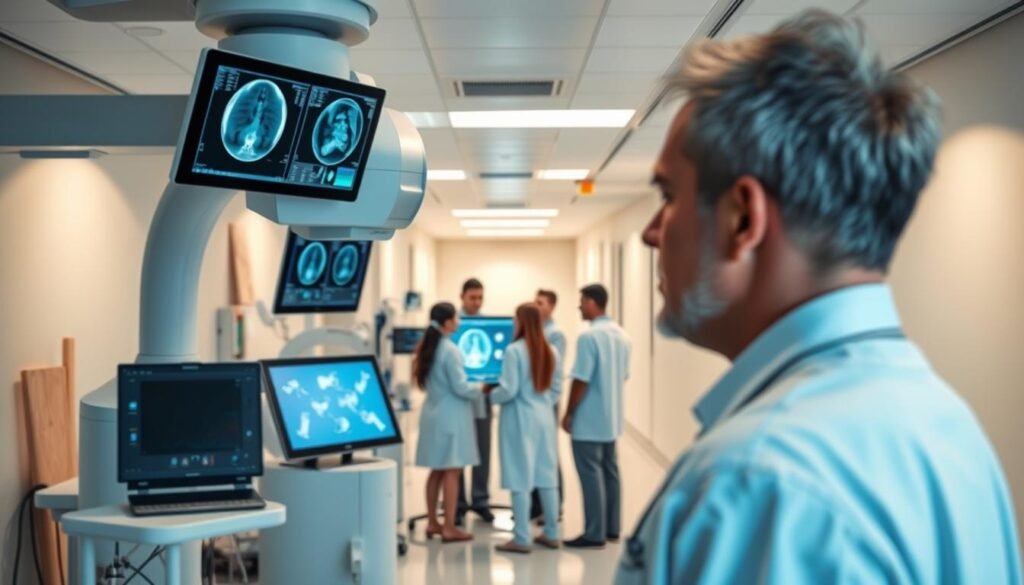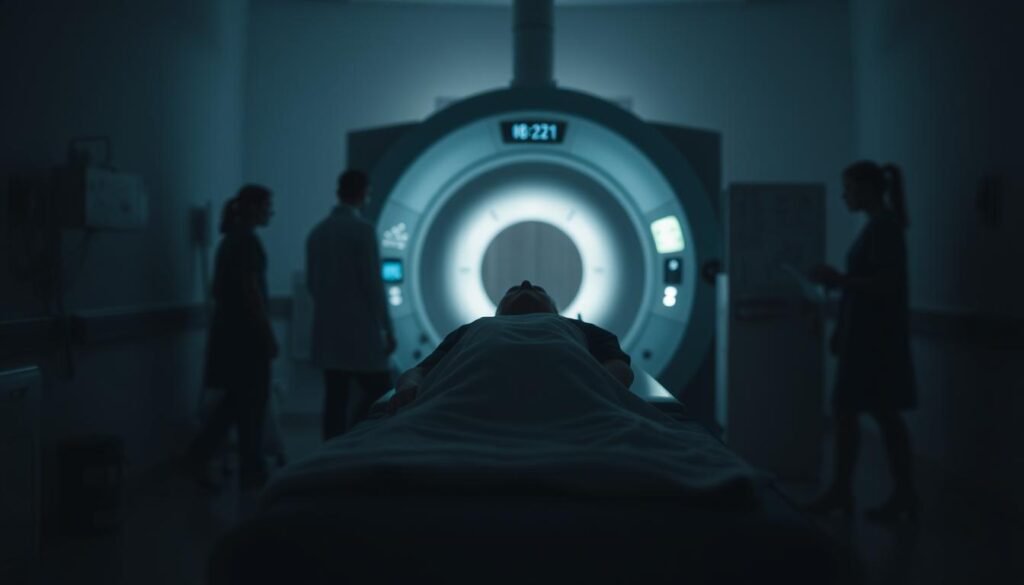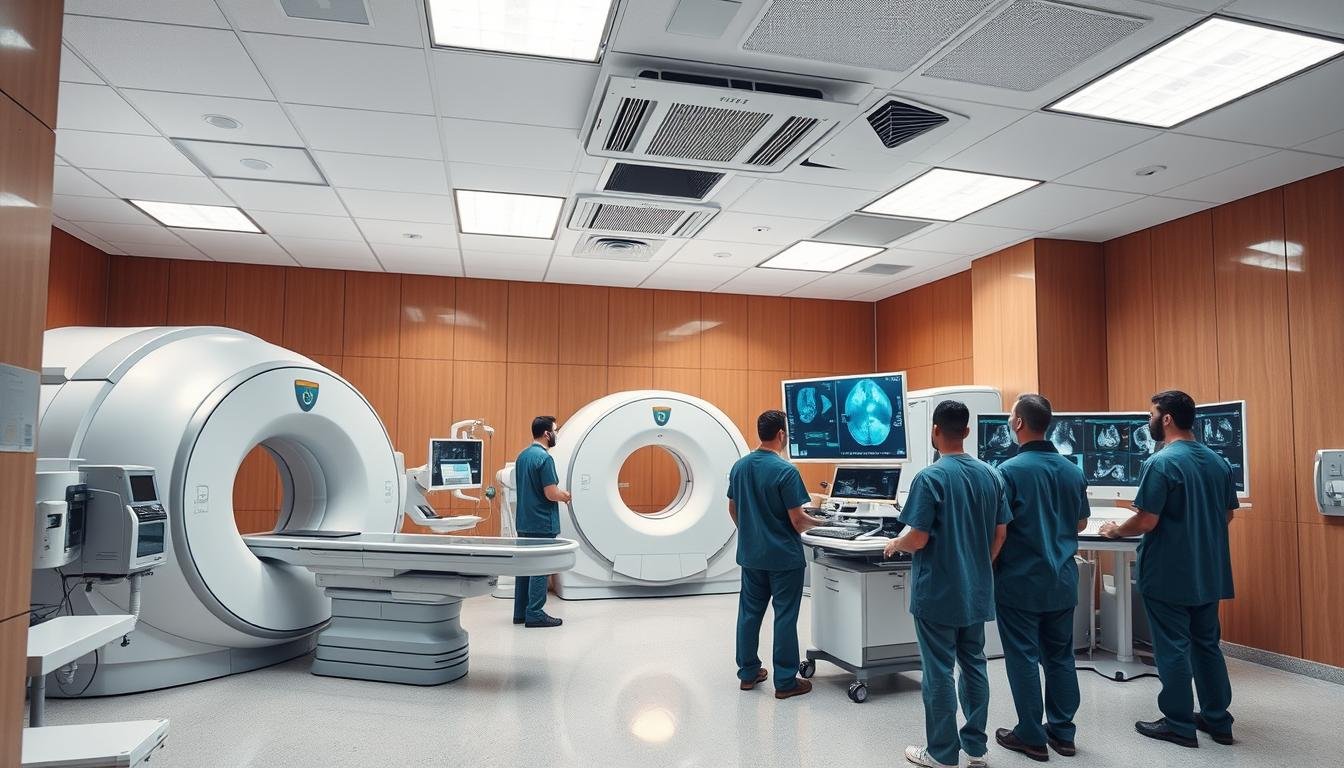Medical Imaging: Revolutionizing Healthcare
Can advanced diagnostic tools be the key to unlocking better patient outcomes? The rapid evolution of radiology and diagnostic imaging is transforming the healthcare landscape, enabling healthcare professionals to diagnose and treat conditions more effectively.
The integration of cutting-edge technologies in medical imaging has significantly improved the accuracy and speed of diagnoses, allowing for timely interventions that can greatly enhance patient care.
As we continue to push the boundaries of what is possible in healthcare, it becomes increasingly clear that the future of medical imaging holds much promise for improving lives.
Key Takeaways
- Advanced radiology techniques are revolutionizing diagnostic capabilities.
- Diagnostic imaging plays a crucial role in modern healthcare.
- Technological advancements are enhancing patient care and outcomes.
- The future of medical imaging is promising and rapidly evolving.
- Early diagnosis through imaging can significantly improve treatment efficacy.
The Evolution of Medical Imaging Technologies
From humble beginnings with X-rays, medical imaging has evolved into sophisticated digital systems that have revolutionized diagnostic capabilities.
From X-rays to Advanced Digital Systems
The journey of medical imaging began with the discovery of X-rays by Wilhelm Conrad Röntgen in 1895. This breakthrough led to the development of radiography, enabling physicians to visualize internal structures without surgery.
Over time, X-ray technology evolved, and new imaging modalities emerged, including Computed Tomography (CT) scans and Magnetic Resonance Imaging (MRI). These advancements have significantly enhanced diagnostic accuracy and patient care.
Key Milestones in Imaging Development
Several key milestones have marked the evolution of medical imaging. The introduction of CT scans in the 1970s allowed for cross-sectional imaging, providing more detailed views of internal anatomy.
The advent of MRI technology further expanded diagnostic capabilities, offering high-resolution images of soft tissues. More recently, advancements in digital radiography have improved image quality and reduced radiation exposure.
These developments have collectively contributed to more accurate diagnoses and effective treatment plans.
Understanding Different Types of Medical Imaging
The field of medical imaging encompasses a range of technologies, each designed to visualize the body’s internal structures. These technologies have revolutionized the way medical professionals diagnose and treat various health conditions.
X-ray Imaging: The Foundation of Diagnostic Radiology
X-ray imaging is one of the oldest and most commonly used diagnostic tools. It involves exposing a part of the body to a small dose of X-ray radiation, which penetrates tissues to varying degrees, creating images of internal structures on a digital detector or film. X-rays are particularly useful for examining bones, lungs, and certain other internal organs.
Computed Tomography (CT) Scans
CT scans combine a series of X-ray images taken from different angles to create cross-sectional images of the inside of the body. This modality is particularly useful for detailed imaging.
How CT Scans Work
During a CT scan, the patient is moved through a doughnut-shaped machine that rotates an X-ray source and detectors around the body, capturing detailed images.
Common Applications
CT scans are commonly used for diagnosing conditions such as injuries, cancers, and vascular diseases, providing detailed insights that guide treatment decisions.
Magnetic Resonance Imaging (MRI)
MRI uses powerful magnetic fields and radio waves to generate detailed images of the body’s internal structures without using X-rays. This makes MRI a safer option for certain patients, particularly for soft tissue imaging.
Principles of MRI Technology
MRI technology relies on the principles of nuclear magnetic resonance to differentiate between various types of tissues based on their magnetic properties.
When MRIs Are Recommended
MRIs are often recommended for diagnosing conditions affecting the brain, spine, joints, and internal organs, where detailed soft tissue imaging is required.
Ultrasound Technology
Ultrasound imaging uses high-frequency sound waves to create images of the inside of the body. It is a non-invasive and safe diagnostic tool, particularly useful for examining fetal development during pregnancy and assessing abdominal organs.
Positron Emission Tomography (PET) Scans
PET scans involve injecting a small amount of radioactive tracer into the body, which is then detected by the PET scanner, providing information on metabolic activities within the body. PET scans are particularly useful for diagnosing and monitoring cancers, neurological disorders, and cardiovascular diseases.
Each of these imaging modalities has its unique strengths and applications, contributing to a comprehensive diagnostic toolkit for healthcare professionals. By understanding the different types of medical imaging available, patients and clinicians can make informed decisions about diagnostic pathways.
How Medical Imaging Transforms Diagnostic Capabilities
Diagnostic imaging has become a cornerstone in modern healthcare, transforming how diseases are detected and treated. The advancements in medical imaging technologies have significantly improved diagnostic accuracy, enabling healthcare professionals to provide timely and effective treatments.
Early Detection of Diseases
One of the most significant benefits of medical imaging is its ability to facilitate the early detection of diseases. Medical imaging technologies such as CT scans and MRI have revolutionized the field by allowing for the identification of conditions at their earliest stages.
Cancer Screening Advancements
The early detection of cancer is crucial for effective treatment. Advanced imaging techniques have improved cancer screening, enabling the detection of tumors at a much earlier stage than previously possible. This has significantly improved patient outcomes in cancer treatment.
Cardiovascular Disease Detection
Medical imaging also plays a critical role in detecting cardiovascular diseases. Techniques such as CT scans and MRI allow for the detailed visualization of the heart and its blood vessels, helping in the early detection of conditions like coronary artery disease.
Precision in Diagnosis
Medical imaging has also enhanced the precision of diagnoses. With technologies like MRI and CT scans, healthcare providers can obtain detailed images of internal structures, allowing for more accurate diagnoses. This precision is crucial in developing effective treatment plans.
Reducing Invasive Procedures
The use of medical imaging has reduced the need for invasive diagnostic procedures. By providing clear images of internal structures, imaging technologies help healthcare professionals diagnose conditions without the need for surgery or other invasive methods, thereby improving patient comfort and reducing recovery times.
The Role of Medical Imaging in Treatment Planning
With the advent of sophisticated medical imaging technologies, treatment planning has become more nuanced and tailored to individual patient needs. Medical imaging plays a crucial role in this process, enabling healthcare professionals to develop targeted treatment strategies.
Surgical Preparation and Guidance
Medical imaging significantly enhances surgical preparation and guidance. Techniques such as 3D modeling for surgical planning allow surgeons to visualize complex anatomical structures in detail, facilitating more precise preoperative planning.
3D Modeling for Surgical Planning
The use of 3D modeling in surgical planning has revolutionized the field of surgery. By creating detailed three-dimensional models from imaging data, surgeons can better understand the anatomy and plan their approach accordingly. This has led to improved surgical outcomes and reduced complications.
Intraoperative Imaging
Intraoperative imaging enables surgeons to visualize the surgical site in real-time during the procedure. This capability is crucial for ensuring the accuracy of the surgical intervention and making any necessary adjustments on the fly.
Radiation Therapy Planning
Medical imaging is also pivotal in radiation therapy planning. Imaging modalities like PET scans and MRI provide critical information about the tumor’s size, shape, and location, allowing for more precise targeting of radiation beams and minimizing exposure to surrounding healthy tissues.
Monitoring Treatment Progress
Furthermore, medical imaging plays a vital role in monitoring the progress of treatment. Regular imaging assessments enable healthcare providers to evaluate the effectiveness of the treatment and make necessary adjustments to the treatment plan.

The integration of advanced medical imaging technologies into treatment planning has significantly improved patient outcomes. By enhancing the precision and effectiveness of various treatments, medical imaging continues to revolutionize the field of healthcare.
Artificial Intelligence and Medical Imaging
Artificial intelligence is transforming the landscape of medical imaging, enhancing both accuracy and efficiency. The integration of AI technologies into diagnostic workflows is revolutionizing how healthcare professionals interpret imaging data, leading to more precise diagnoses and effective treatment plans.
AI-Assisted Diagnosis
AI-assisted diagnosis is a significant advancement in medical imaging, leveraging machine learning algorithms to analyze complex imaging data. These algorithms can identify patterns that may elude human observers, improving diagnostic accuracy.
Machine Learning Algorithms
Machine learning algorithms are trained on vast datasets of medical images, enabling them to recognize abnormalities and predict patient outcomes. This training allows for more accurate diagnoses and personalized treatment plans.
Computer-Aided Detection
Computer-aided detection (CAD) systems assist radiologists in identifying potential areas of concern within images. CAD systems have been shown to improve detection rates for certain conditions, such as breast cancer.
Image Enhancement and Reconstruction
AI is also being used to enhance and reconstruct medical images, improving their quality and clarity. Techniques such as deep learning-based image reconstruction can reduce noise and artifacts, leading to more accurate diagnoses.
Image enhancement techniques are particularly valuable in cases where image quality is compromised due to factors like patient motion or equipment limitations.
Predictive Analytics in Imaging
Predictive analytics, powered by AI, is emerging as a powerful tool in medical imaging. By analyzing imaging data in conjunction with other patient information, predictive models can forecast disease progression and treatment outcomes.
This capability enables healthcare providers to develop proactive treatment strategies, potentially improving patient outcomes.
Patient Experience in Modern Medical Imaging
As medical imaging technologies evolve, the focus on patient comfort and safety has become more pronounced. Modern medical imaging is not just about obtaining high-quality diagnostic images; it’s also about ensuring that patients have a positive experience during the process.
Reducing Anxiety and Discomfort
One of the significant advancements in medical imaging is the effort to reduce patient anxiety and discomfort. Techniques such as open MRI machines and claustrophobia-friendly MRI systems have been developed to alleviate the stress associated with traditional MRI procedures. Additionally, some imaging facilities now offer relaxation techniques, such as calming music or virtual reality experiences, to help patients relax during the procedure.
Faster and More Accessible Procedures
The development of faster and more efficient imaging technologies has also improved the patient experience. For instance, advanced CT scanners can now capture images in a matter of seconds, reducing the time patients spend in the scanner. Furthermore, the increasing availability of portable imaging devices is making medical imaging more accessible to a wider range of patients, including those in remote or underserved areas.
Radiation Safety Considerations
Radiation safety is a critical aspect of medical imaging, particularly for procedures involving ionizing radiation, such as X-rays and CT scans. Efforts to minimize radiation exposure while maintaining image quality are ongoing.
Dose Reduction Techniques
One approach to reducing radiation exposure is through dose reduction techniques. These include using the lowest necessary dose of radiation to achieve diagnostic image quality and implementing iterative reconstruction algorithms to improve image quality at lower doses.
Risk-Benefit Assessment
It’s also essential to conduct a thorough risk-benefit assessment for each patient. This involves weighing the potential benefits of the imaging procedure against the risks associated with radiation exposure. Healthcare providers must consider factors such as the patient’s age, medical history, and the specific clinical question being addressed.
By focusing on patient comfort, accessibility, and radiation safety, modern medical imaging is enhancing the overall patient experience. As technology continues to evolve, we can expect further improvements in these areas, leading to better outcomes for patients.
The Future of Medical Imaging Technologies
Medical imaging is on the cusp of a revolution, driven by cutting-edge technologies and innovative approaches. As we look to the future, it’s clear that medical imaging will continue to play a vital role in healthcare, enabling earlier diagnosis, more effective treatment, and better patient outcomes.
Emerging Imaging Modalities
The field of medical imaging is witnessing the emergence of new modalities that promise to enhance diagnostic capabilities. Two such modalities are making significant strides:
Photoacoustic Imaging
Photoacoustic imaging combines the advantages of optical and ultrasound imaging, providing high-resolution images of tissues. This technique uses laser light to generate ultrasound waves, which are then detected to create detailed images.
Molecular Imaging
Molecular imaging allows for the visualization of biological processes at the molecular level. This modality enables clinicians to diagnose diseases earlier and monitor treatment response more effectively.
Portable and Point-of-Care Imaging
The development of portable and point-of-care imaging devices is transforming the way medical imaging is delivered. These devices enable healthcare providers to perform imaging procedures at the bedside or in remote locations, improving patient care and reducing healthcare costs.
A comparison of traditional and portable imaging devices is shown in the table below:
| Feature | Traditional Imaging | Portable Imaging |
|---|---|---|
| Location | Fixed within radiology departments | Can be used at bedside or remote locations |
| Cost | High initial investment and maintenance | Lower costs, more accessible |
| Accessibility | Limited by location and availability | Increased accessibility for patients |
Integration with Virtual and Augmented Reality
The integration of medical imaging with virtual and augmented reality (VR/AR) technologies is an exciting development. This integration has the potential to enhance diagnostic accuracy, improve surgical planning, and provide more immersive training for healthcare professionals.
As these emerging technologies continue to evolve, we can expect to see significant advancements in the field of medical imaging, ultimately leading to better patient care and outcomes.
Challenges and Ethical Considerations in Medical Imaging
Despite its benefits, medical imaging is not without its challenges, including issues related to data privacy and access equity. As medical imaging technologies continue to advance, they present both opportunities for improved healthcare and challenges that need to be addressed.

Data Privacy and Security
One of the significant challenges in medical imaging is ensuring the privacy and security of patient data. With the increasing use of digital imaging, there is a growing concern about the potential for data breaches and unauthorized access to sensitive medical information.
Robust security measures are essential to protect patient data and maintain trust in medical imaging technologies. This includes implementing advanced encryption methods and secure data storage solutions.
Overutilization Concerns
Another challenge is the potential for the overutilization of medical imaging. The ease of access to advanced imaging technologies can sometimes lead to unnecessary procedures, which not only increase healthcare costs but also expose patients to unnecessary radiation.
Guidelines and protocols are being developed to ensure that medical imaging is used judically and only when necessary. This includes assessing the appropriateness of imaging procedures based on clinical criteria.
Equity in Access to Advanced Imaging
Equity in access to medical imaging is another critical issue. There are disparities in the availability of advanced imaging technologies across different regions, with some areas having limited or no access to these services.
Efforts to address these disparities include increasing the availability of imaging technologies in underserved areas and promoting policies that support equitable access to healthcare services.
Conclusion: Embracing the Medical Imaging Revolution
The medical imaging landscape has undergone a significant transformation, revolutionizing healthcare by providing unparalleled diagnostic capabilities. As we have explored, advancements in medical imaging technologies have enabled early disease detection, precision in diagnosis, and reduced invasive procedures.
Diagnostic imaging has become a cornerstone in treatment planning, surgical preparation, and radiation therapy. The integration of artificial intelligence has further enhanced diagnostic accuracy and image reconstruction. As medical imaging continues to evolve, emerging modalities and portable imaging solutions are poised to expand access to quality care.
To fully harness the potential of medical imaging, continued innovation and investment are crucial. By embracing this revolution, healthcare providers can improve patient outcomes, streamline clinical workflows, and reduce costs. As the medical imaging landscape continues to advance, it is essential to prioritize data privacy, security, and equity in access to these life-changing technologies.







